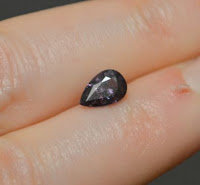Honestly, now that I have learned the basics of stone setting, I could spend all my time thinking up new things to make, and working in the studio…but I’m getting ahead of myself. You will recall that I started thinking about this part of the class months ago – and started looking at cabochons for the two pendants I would make in class.
 I had a very clear mental
image of how I wanted my Fordite pendant to turn out – and I couldn’t be
more pleased with the final result. It helps that I had really great
instruction, and that because of its composition, Fordite turned out to
be an excellent material for my first bezel set piece.
I had a very clear mental
image of how I wanted my Fordite pendant to turn out – and I couldn’t be
more pleased with the final result. It helps that I had really great
instruction, and that because of its composition, Fordite turned out to
be an excellent material for my first bezel set piece. Once again -we started with just a couple of pieces of plain silver. A square of 20 gauge sheet for the backing and bail, and bezel wire. The first steps were to size and shape the bezel and solder it to the silver sheet. Because I wanted my piece to have a hammered texture, I did that first, before attaching the bezel to the backing.
Once again -we started with just a couple of pieces of plain silver. A square of 20 gauge sheet for the backing and bail, and bezel wire. The first steps were to size and shape the bezel and solder it to the silver sheet. Because I wanted my piece to have a hammered texture, I did that first, before attaching the bezel to the backing.At the suggestion of my instructor, I added a cut out heart to the back of the bezel - a little something extra. I really liked this idea because it helps tell the story of each piece of jewelry.
After finishing the opening on the reverse, I cut my bezel backing to the shape I wanted, created a bail and a jump ring, and was ready to solder all my pieces together and polish them.
 Setting the stone is the very last thing - so once my setting was clean, shiny and finished on the edges, I put my fordite into the bezel and tightened it to hold the cabochon in. The result is a beautiful pendant that I am really, really enjoying.
Setting the stone is the very last thing - so once my setting was clean, shiny and finished on the edges, I put my fordite into the bezel and tightened it to hold the cabochon in. The result is a beautiful pendant that I am really, really enjoying.Our final week was also devoted to stone setting - this time with tabs rather than bezels. A somewhat simpler technique (although I confess I prefer the bezels) - and good for irregular stones, it just what it sounds like - creating tabs that hold a stone in place against a backing.
For this project I chose a triangular labradorite cabochon, and decided to put an Erlenmeyer flask cut out on the back - a nod to my daughter, I'm calling this piece "chem lab".
The first steps included sawing out the reverse opening, and space in the tabs so that they could be folded over the stone. After getting the backing filed down to the proper size, I realized I hadn't fully thought through how to attach the bail...of course...this is why we have instructors, and Shalena came to my aid.
 She helped me bend up the top tab so that I could position and solder on a jump ring, then it was time to think about a bail. I decided I wanted the bail to follow the open triangle design I had for the tabs, so I formed one using square wire. The result was a split bail, that looked great on the finished pendant.
She helped me bend up the top tab so that I could position and solder on a jump ring, then it was time to think about a bail. I decided I wanted the bail to follow the open triangle design I had for the tabs, so I formed one using square wire. The result was a split bail, that looked great on the finished pendant. I learned SO much in this class - and I am so pleased with how the pieces turned out. I'm looking forward to spending time in open studio working on my metal skills between now and my next class (probably Fabrication 201 in the spring).
I learned SO much in this class - and I am so pleased with how the pieces turned out. I'm looking forward to spending time in open studio working on my metal skills between now and my next class (probably Fabrication 201 in the spring).Until next time.

















